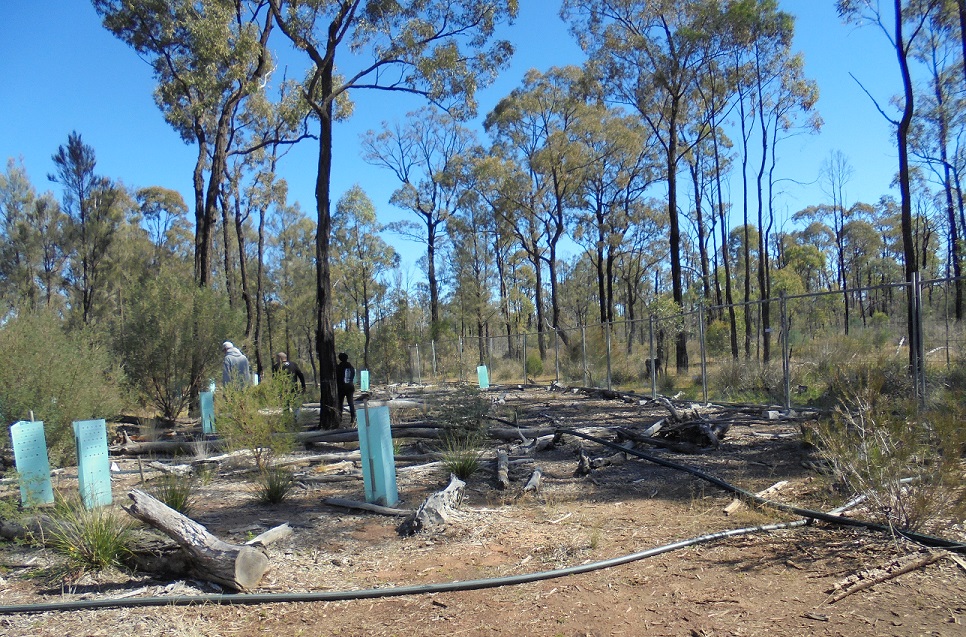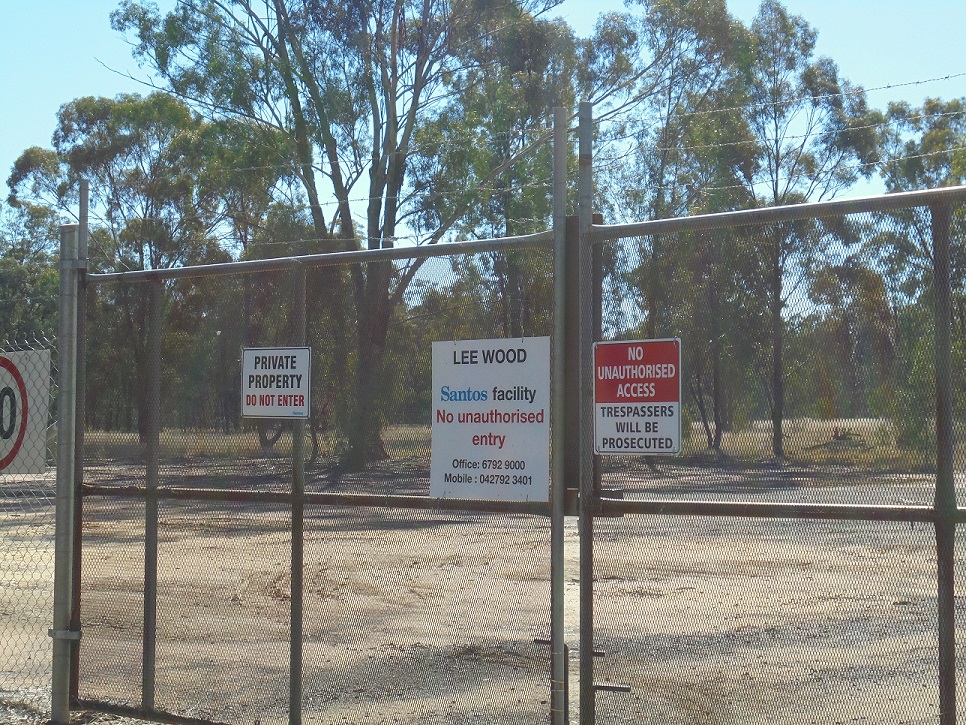
Dan Lanzini and Gomilleroi man Kodi Brady are committed to saving the Pilliga State Forest, the last remaining substantial temperate forest in Australia. Both are active in the campaign against Santos’ push to set up industrial-scale coal seam gas (CSG) wells in this north-west New South Wales forest.
Despite Santos’ protestations that its practice shows it can manage the priceless and unique area well, our recent tour of its operations showed the opposite: Santos has already destroyed parts of the forest.
Now, it wants to build 850 wells the first, it hope,s of more gas projects for the north-west.
Lanzini is a founder of the North West Protection Advocacy (NWPA) group. Brady, a resident of Coonabarabran, is a Warrumbungle Shire Councillor.
They showed us a test well inside the forest, where spills had taken place and Santos’ efforts at regeneration.
According to Lanzini there is “no such thing” as an exploration well. “They are all production wells. If Santos don’t get this gas field approved, they will lose big money — that’s why they are desperate.”
Pointing to the huge flares coming from the wells, he said if the project gets the go-ahead from the Independent Planning Commission (IPC), Santos will produce large-scale toxic pollution for many years.
“The gas from these 25 exploration wells is already operating power generators and yet Santos is paying no tax because they are considered ‘exploration’ wells only.”
As we drove by some spills from the wells, Lanzini pointed out where Santos had supposedly regenerated the forest. There was no life in these “dead zones”. There have been 22 toxic waste spills so far.
“You can see the results of ‘regeneration work’ carried out by Santos in these areas”, he said. “The company attempts to grow plants, and they die. The dead zones grow bigger every year, as the poison spreads.” Santos wants to set up 850 wells in an area of about 1200 square kilometres.
Pilliga State Forest spillage site where regrowth all dies coral wynter smaller.jpg

Santos has told the IPC it will safely dispose of the salt waste, but its past practice shows it has not done this.
“Over eight years, Santos had only admitted to producing 480,000 tonnes of salt waste. This amount suddenly jumped to 800,000 tonnes in the report to the Independent Planning Commission (IPC),” Lanzini said.
“There will be 250 trucks of salt waste every day. The [disposal] job will be offloaded to another company, to dispose of in a toxic hole inside the Pilliga Forest.
“The brine waste water is intended to be crystallised, to be ‘disposed of’. The resulting waste product is supposed to be sent out of the area on the proposed new inland rail line.”
Sacrifice zone
There is a close connection between Santos and the National Party. “Former National Party leader John Anderson runs the inland rail corporation. Previously, he headed the Eastern Star gas company, which sold its holdings to Santos for $1 billion. This is just one example of National Party collusion,” Lanzini said, adding these “mates’ clubs” are not concerned about how the Pilliga has become a “sacrifice zone”.
We also saw the Bimbilwindi spill zone, which includes two waste water dams and a large storage tank.
“Officially, there are 10,000 litres of waste here,” Lanzini said. “More likely, though, there are at least 100,000 litres.
“Many trees have died here, others have been defoliated. Every time it rains, the toxins spread further.
“Santos has spent $20 million on this site. The toxins flow downstream to Narrabri from here, along the Bimbilwindi Creek.
“These saltwater dams, called ‘storage dams’, are filled up with toxic chemicals. The dams overflow regularly, and also crack and fail. The waste water includes radioactive uranium.”
Another potential catastrophic problem is that high voltage power lines are going to be constructed throughout the Pilliga.
“Gas flares will be placed at the wells, on 50-metre high stands, with the flares reaching some 30 metres higher.”
This means that, in an increasingly dry forest, the danger of fires is severe. “The flares will be operating constantly, with the exhaust including every kind of toxic gas. This is known as ‘sour gas’ — 60% methane with 40% being ‘wasted’.”
Scientists at the Siding Spring Observatory, in the nearby Warrumbungle Mountains, have warned of a potential catastrophe from the increased light from the gas flares.
“If the observatory is forced to close, it would have a drastic impact on jobs in the Coonabarabran region, as Siding Spring is the second-biggest employer in the town.”
During the IPC hearings in Narrabri, the NWPA held a safe gathering at the Narrabri Bowling Club, Lanzini said, including a concert against gas. It was a rallying point for locals opposed to the CSG project and brought farmers, Aboriginal people and residents together.
“We have organised multiple lock-ons to disrupt work on the drill sites and camps to block the gates of the test areas,” Lanzini said.
Great Artesian Basin
The Pilliga Forest is a big sponge for the Great Artesian Basin. It filters the water into the soil and acts as the major recharge source for the whole of the state.
“Billions of litres of this water will be removed by Santos, and replaced by salty waste water which threatens the future of the Great Artesian Basin,” Lanzini said.
Leewood reverse osmosis plant coral wynter smaller.jpg

We visited Santos’ Leewood water storage facility near the Newell Highway, where the company wants to build multiple reverse osmosis plants supposedly to turn toxic salt waste into sodium bicarbonate.
“The waste water here is full of sulphur and other toxic chemicals. The liquid eats into concrete, steel and other materials”, Lanzini said.
“This is happening all over Queensland’s gas fields, where the CSG waste is destroying the land and the water. We don’t want this here in northern NSW.”
About 50 people were arrested trying to enter the facility during a previous protest.
We stopped to see the largely dry Bohena Creek bed. Brady explained that it contains the last permanent waterhole in the Pilliga.
He also showed us ancient scar trees, which featured large cut-out sections, from which First Nations people had made tools, weapons, canoes, containers and other artefacts over thousands of years of custodianship.
Brady was one of some 400 people to address the IPC public hearings. “The people of Coonabarabran are a resilient lot; we endure quite a lot of hardship in silence,” he told the commissioners.
The July 30 Coonabarabran Times reported him telling the commissioners that: “It takes a lot to get us to speak out. But here we are today, to speak out. CSG mining is dirty. It leaks methane. It involves moving toxic substances into open air pools. It will poison the waters of the Great Artesian Basin.
“How much? Who knows? When? Who knows?
“It will pollute our gorgeous night sky, the first Dark Sky Park in Australia, with needless light.
“The Pilliga doesn’t belong to us; we belong to it.
“And like the bushfires, we fear every season, CSG is a year-round danger to the environment.”
[Coral Wynter and Jim McIllroy will speak about their tour of the Pilliga, alongside a Sydney Knitting Nanna on Tuesday August 25 in an online forum hosted by Green Left. The zoom link is https://us02web.zoom.us/j/81873178252.]